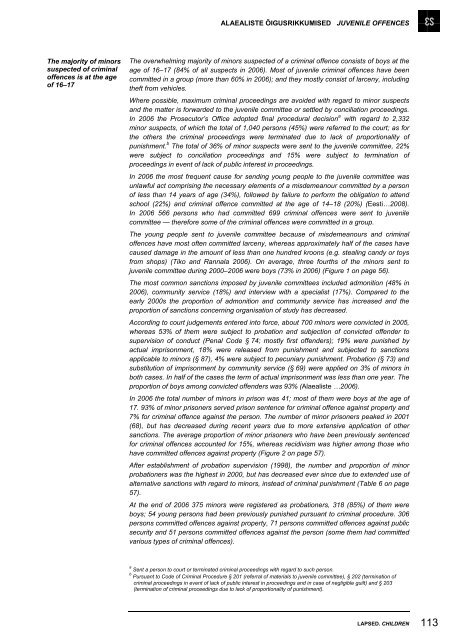LAPSED CHILDREN - Tartu Ãlikool
LAPSED CHILDREN - Tartu Ãlikool
LAPSED CHILDREN - Tartu Ãlikool
- No tags were found...
You also want an ePaper? Increase the reach of your titles
YUMPU automatically turns print PDFs into web optimized ePapers that Google loves.
ALAEALISTE ÕIGUSRIKKUMISED JUVENILE OFFENCES<br />
The majority of minors<br />
suspected of criminal<br />
offences is at the age<br />
of 16–17<br />
The overwhelming majority of minors suspected of a criminal offence consists of boys at the<br />
age of 16–17 (84% of all suspects in 2006). Most of juvenile criminal offences have been<br />
committed in a group (more than 60% in 2006); and they mostly consist of larceny, including<br />
theft from vehicles.<br />
Where possible, maximum criminal proceedings are avoided with regard to minor suspects<br />
and the matter is forwarded to the juvenile committee or settled by conciliation proceedings.<br />
In 2006 the Prosecutor’s Office adopted final procedural decision a with regard to 2,332<br />
minor suspects, of which the total of 1,040 persons (45%) were referred to the court; as for<br />
the others the criminal proceedings were terminated due to lack of proportionality of<br />
punishment. b The total of 36% of minor suspects were sent to the juvenile committee, 22%<br />
were subject to conciliation proceedings and 15% were subject to termination of<br />
proceedings in event of lack of public interest in proceedings.<br />
In 2006 the most frequent cause for sending young people to the juvenile committee was<br />
unlawful act comprising the necessary elements of a misdemeanour committed by a person<br />
of less than 14 years of age (34%), followed by failure to perform the obligation to attend<br />
school (22%) and criminal offence committed at the age of 14–18 (20%) (Eesti…2008).<br />
In 2006 566 persons who had committed 699 criminal offences were sent to juvenile<br />
committee — therefore some of the criminal offences were committed in a group.<br />
The young people sent to juvenile committee because of misdemeanours and criminal<br />
offences have most often committed larceny, whereas approximately half of the cases have<br />
caused damage in the amount of less than one hundred kroons (e.g. stealing candy or toys<br />
from shops) (Tiko and Rannala 2006). On average, three fourths of the minors sent to<br />
juvenile committee during 2000–2006 were boys (73% in 2006) (Figure 1 on page 56).<br />
The most common sanctions imposed by juvenile committees included admonition (48% in<br />
2006), community service (18%) and interview with a specialist (17%). Compared to the<br />
early 2000s the proportion of admonition and community service has increased and the<br />
proportion of sanctions concerning organisation of study has decreased.<br />
According to court judgements entered into force, about 700 minors were convicted in 2005,<br />
whereas 53% of them were subject to probation and subjection of convicted offender to<br />
supervision of conduct (Penal Code § 74; mostly first offenders); 19% were punished by<br />
actual imprisonment, 18% were released from punishment and subjected to sanctions<br />
applicable to minors (§ 87), 4% were subject to pecuniary punishment. Probation (§ 73) and<br />
substitution of imprisonment by community service (§ 69) were applied on 3% of minors in<br />
both cases. In half of the cases the term of actual imprisonment was less than one year. The<br />
proportion of boys among convicted offenders was 93% (Alaealiste …2006).<br />
In 2006 the total number of minors in prison was 41; most of them were boys at the age of<br />
17. 93% of minor prisoners served prison sentence for criminal offence against property and<br />
7% for criminal offence against the person. The number of minor prisoners peaked in 2001<br />
(68), but has decreased during recent years due to more extensive application of other<br />
sanctions. The average proportion of minor prisoners who have been previously sentenced<br />
for criminal offences accounted for 15%, whereas recidivism was higher among those who<br />
have committed offences against property (Figure 2 on page 57).<br />
After establishment of probation supervision (1998), the number and proportion of minor<br />
probationers was the highest in 2000, but has decreased ever since due to extended use of<br />
alternative sanctions with regard to minors, instead of criminal punishment (Table 6 on page<br />
57).<br />
At the end of 2006 375 minors were registered as probationers, 318 (85%) of them were<br />
boys; 54 young persons had been previously punished pursuant to criminal procedure. 306<br />
persons committed offences against property, 71 persons committed offences against public<br />
security and 51 persons committed offences against the person (some them had committed<br />
various types of criminal offences).<br />
a Sent a person to court or terminated criminal proceedings with regard to such person.<br />
b Pursuant to Code of Criminal Procedure § 201 (referral of materials to juvenile committee), § 202 (termination of<br />
criminal proceedings in event of lack of public interest in proceedings and in case of negligible guilt) and § 203<br />
(termination of criminal proceedings due to lack of proportionality of punishment).<br />
<strong>LAPSED</strong>. <strong>CHILDREN</strong> 113

















